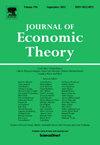Business cycles fluctuations in three-sector intertemporal equilibrium models
IF 1.2
3区 经济学
Q3 ECONOMICS
引用次数: 0
Abstract
This paper introduces a novel mechanism driving endogenous business cycle fluctuations within a frictionless three-sector intertemporal equilibrium model. We emphasize the critical role of consumer preferences as a primary driver of cyclical dynamics by considering a consumption bundle composed of a pure consumption good and a mixed consumption-investment good that simultaneously serves as both a final consumption good and a capital-accumulating investment good. Endogenous fluctuations naturally arise from sectoral capital intensity differences, an intertemporal consumption trade-off between the two goods, or the interaction of both mechanisms. We offer a detailed characterization of the economy's dynamics, identifying the Hopf bifurcation conditions that trigger persistent cyclical behavior. Additionally, we explore the periodicity of the resulting limit cycles, providing insights into how shifts in preferences and sectoral complementarities can generate self-sustained macroeconomic fluctuations.
三部门时际均衡模型中的商业周期波动
本文在无摩擦三部门跨期均衡模型中引入了一种驱动内生商业周期波动的新机制。我们通过考虑由纯消费产品和消费-投资混合产品组成的消费束,强调消费者偏好作为周期动态主要驱动力的关键作用。内生波动自然来自部门资本密集度差异、两种商品之间的跨期消费权衡或两种机制的相互作用。我们提供了经济动态的详细特征,确定了引发持续周期性行为的霍普夫分岔条件。此外,我们还探讨了由此产生的极限周期的周期性,为偏好和部门互补性的变化如何产生自我维持的宏观经济波动提供了见解。
本文章由计算机程序翻译,如有差异,请以英文原文为准。
求助全文
约1分钟内获得全文
求助全文
来源期刊

Journal of Economic Theory
ECONOMICS-
CiteScore
2.50
自引率
12.50%
发文量
135
期刊介绍:
The Journal of Economic Theory publishes original research on economic theory and emphasizes the theoretical analysis of economic models, including the study of related mathematical techniques. JET is the leading journal in economic theory. It is also one of nine core journals in all of economics. Among these journals, the Journal of Economic Theory ranks fourth in impact-adjusted citations.
 求助内容:
求助内容: 应助结果提醒方式:
应助结果提醒方式:


